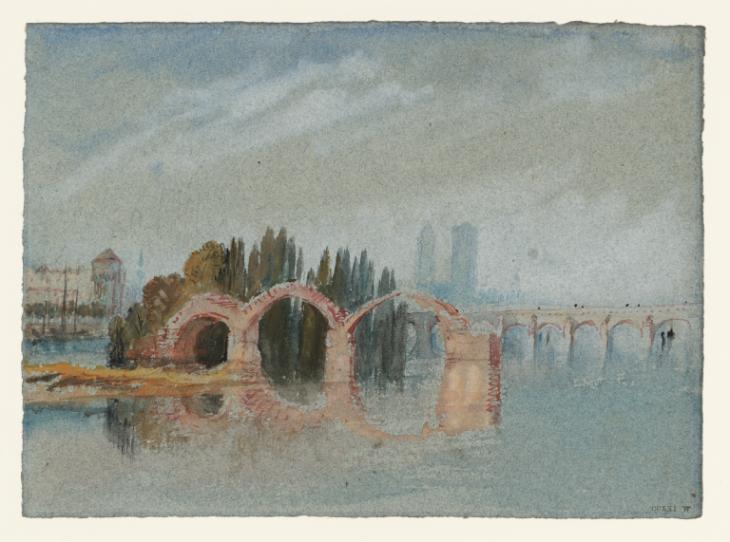Joseph Mallord William Turner Ruins of the Old Pont Eudes, Tours c.1826-8
Joseph Mallord William Turner,
Ruins of the Old Pont Eudes, Tours
c.1826-8
Joseph Mallord William Turner 1775–1851
Ruins of the Old Pont Eudes, Tours c.1826–8
D20256
Turner Bequest CCXXI W
Turner Bequest CCXXI W
Pencil, watercolour and gouache on blue paper, 139 x 191 mm
Stamped in black ‘CCLIX W’ bottom right
Stamped in black ‘CCLIX W’ bottom right
Accepted by the nation as part of the Turner Bequest 1856
Exhibition history
1938
Four Screens, British Museum, London, March–September 1938 (frame 13, as ‘A Ruined Bridge’).
1982
J.M.W. Turner Watercolors from the British Museum, Georgia Museum of Art, University of Georgia, Athens, March–May 1982, Museum of Fine Arts, Houston, May–July (56).
1991
Turner: The Fourth Decade: Watercolours 1820–1830, Tate Gallery, London, January–May 1991 (49).
1997
Turner on the Loire, Tate Gallery, London, September 1997–February 1998, Château de Blois, March–June, Musée du château des ducs de Bretagne, Nantes, June–September (86).
References
1909
A.J. Finberg, A Complete Inventory of the Drawings of the Turner Bequest, London 1909, vol.II, p.689, CCXXI W, as ‘Bridge, with trees’.
1991
Ian Warrell, Turner: The Fourth Decade: Watercolours 1820–1830, exhibition catalogue, Tate Gallery, London 1991, p.52 no.49.
1997
Ian Warrell, Turner on the Loire, exhibition catalogue, Tate Gallery, London 1997, pp.123 fig.119, 124–5, 223 no. 86, 236, 238.
Technique and condition
The blue wove paper used for this study, of a type Turner regularly used from his middle years, forms an integral part of the composition. The two bridges, the trees and the more distant buildings to the left were freely painted in watercolour washes with nonetheless careful placing, since the reflection of the nearer bridge and the trees, and the buildings on the far bank, define the full reach of the river, represented by the blue paper and a few light blue watercolour washes. Less pale blue washes and thin applications of white gouache, which both allow the blue paper to make some optical contribution to the surface colour, define the sky. Pigments used include vermilion sometimes combined with lead white for paler pink areas, mid-chrome yellow, yellow and brown ochres combined with black to paint the trees, and possibly cobalt blue. Cobalt blue has a greenish blue tone suitable for a sunlit sky, and Turner used it occasionally for this purpose in watercolour, but far more frequently in oil. In ultraviolet light it has a weak fluorescence, which can serve to identify it when it is used as a pure colour wash.
Helen Evans
October 2008
Revised by Joyce Townsend
March 2011
How to cite
Helen Evans, 'Technique and Condition', October 2008, revised by Joyce Townsend, March 2011, in John Chu, ‘Ruins of the Old Pont Eudes, Tours c.1826–8 by Joseph Mallord William Turner’, catalogue entry, March 2016, in David Blayney Brown (ed.), J.M.W. Turner: Sketchbooks, Drawings and Watercolours, Tate Research Publication, March 2017, https://wwwThis colour sketch, formerly thought to depict a scene on the Rivers Meuse or Moselle, has been identified by Turner specialist, Ian Warrell, as a vista of Tours from the banks of the Loire.1 The towers of the Cathedral of Saint-Gaetan are only lightly sketched in pencil on the right-hand side of the sheet, which led to this misidentification. More clearly articulated are the towers of the Old Cathedral, the Tour de Guise, the Logis du Gouverneur, and the ruins of the old Pont Eudes at the centre of the composition.2 The sheet was worked up from a pencil sketch in the Loire, Tours, Orleans and Paris sketchbook which he took on his 1826 tour of Northern France (See entry for Tate D23264 (Turner Bequest CCXLIX 10), perhaps with the failed The English Channel or La Manche print series in mind.3 See the Introduction to this section for a list of comparable studies of the city.
Verso:
Blank
John Chu
March 2016
How to cite
John Chu, ‘Ruins of the Old Pont Eudes, Tours c.1826–8 by Joseph Mallord William Turner’, catalogue entry, March 2016, in David Blayney Brown (ed.), J.M.W. Turner: Sketchbooks, Drawings and Watercolours, Tate Research Publication, March 2017, https://www

